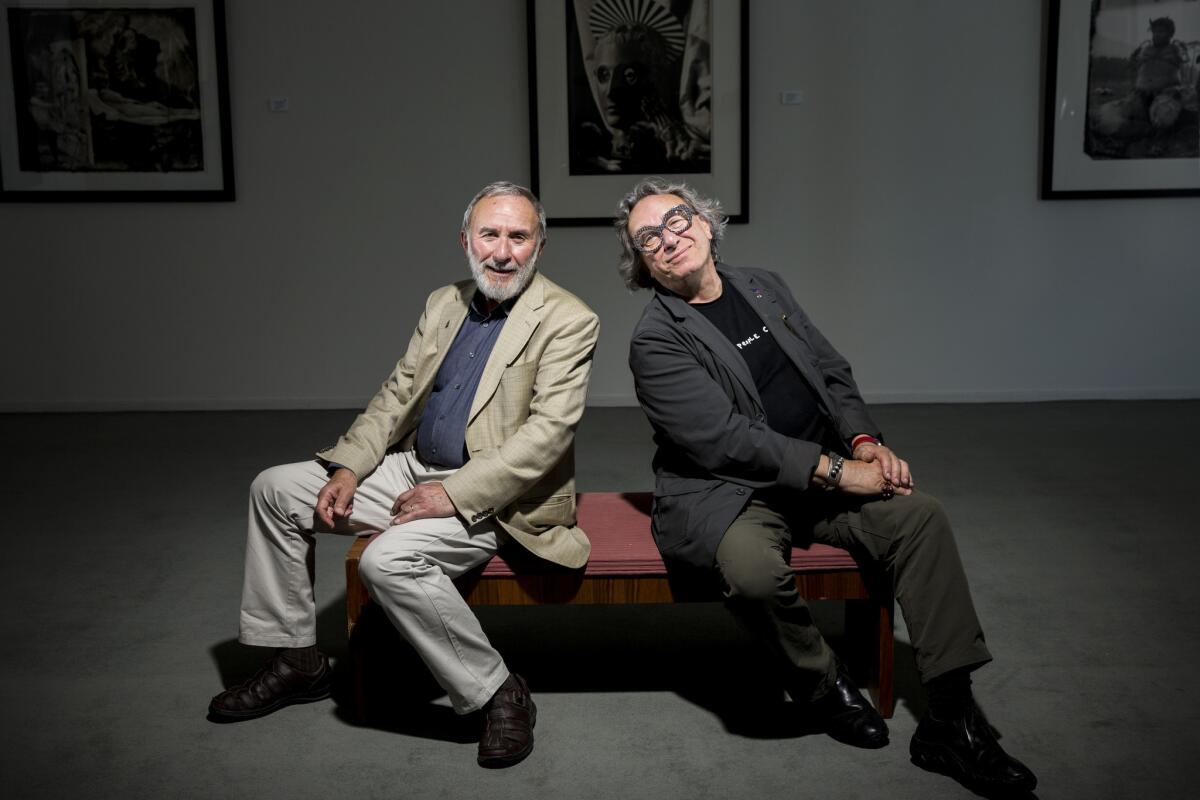Brothers Jerome and Joel-Peter Witkin and their ‘Twin Visions’

If you didn’t know the artists were identical twins, you might not suspect it.
Painter Jerome Witkin and surrealist photographer Joel-Peter Witkin have spent the better part of their 74 years apart. Sure, there was the occasional family gathering, and the men would read about each other in papers and periodicals, but a closeness was lacking.
That changed over the summer with the opening of their first joint show at Jack Rutberg Fine Arts in Los Angeles. Titled “Twin Visions: Jerome Witkin & Joel-Peter Witkin,” the show is a three-room collection of some of the artists’ best known works.
The show proved so popular that Rutberg extended its run for an extra month, he says -- a run that now ends Saturday. He recently released a book featuring both artists’ work under the same title as the show.
“People have flown in from all over the world specifically for this,” Rutberg says.
Indeed, Joel has achieved cult status. His photographs are dark and often nightmarish. They show disfigured models, corpses, amputees, hermaphrodites and other subjects in highly conceptual, meticulously staged tableaux.
For a 1989 Times article, art curator Kristine McKenna visited the photographer’s home and studio in Albuquerque, noting, “Joel-Peter Witkin’s volatile photographs are considered to be the very cutting edge of art form by some, and dismissed as flagrant pornography by others.”
In spite of this reputation, or perhaps because of it, Joel became the more famous of the twins, even though Jerome had begun painting much earlier than Joel began taking photographs. As a young man, Jerome won a Pulitzer fellowship that enabled him to travel and work in Europe.
In 1995, Times’ art critic William Wilson hailed a showing of Jerome’s work as “a moving exhibition offering a breakthrough in post-Cold-War art.”
Jerome is a figurative painter living in New York and a professor of art at Syracuse University. His canvases tend to be huge and his subject matter also not easy to digest. A number of his canvases in “Twin Visions” feature Holocaust atrocities.
The brothers appear to share a vision of life as a dark morality play.
“Everyone in life instinctively knows that they’re in a struggle and we have the capacity -- or incapacity -- to face what we have to face, to make the best of it, or to be plowed under,” Joel says during a meeting with his brother on a recent afternoon at Rutberg’s gallery. “As T.S. Eliot said, ‘Human beings can’t take too much reality.’”
During the meeting, the brothers display an easy back and forth, Joel being the more gregarious of the two. Almost the opposite of his work, he is light-hearted, sometimes clownish, although he can get serious in a flash, and when he does, he is thoughtful and articulate.
Jerome is soft-spoken and introspective as he tells stories about what influenced him as an artist over the years: moments in time, including the death of his 16-year-old son after complications from a bone marrow transplant, and a glimpse of a young girl trying to escape from East Berlin to West Berlin via subway but getting dragged off the train, screaming, right before she made it.
“Why do we make art? What is that moment about, that freedom she lost? What is that anguish?” Jerome asks. “I think of that girl a lot.”
The brothers insist they had no big fight or falling out, but rather simply grew apart as life took them in different directions. Since the “Twin Visions” exhibition opened, the men say they have learned a great deal about each other, realizing their similarities despite their estrangement.
“Independently, through the mediums we work in, we’re both seekers of truth,” Joel says. “We want to inform and elevate other people who see the work through what we found in ourselves and life.”
Adds Jerome, “When you’re an artist you spend time alone, and Joel’s time alone is almost a religious experience with his work.”
Asked what he would say to critics who feel his work exploits his unusual subjects, Joel replies, “I tell myself I have a pathologist’s bedside manner. I can’t be that person. That person can spend six or seven hours with me and I know inwardly that I can make a profound photograph of them with what I see or sense.”
Now that the twins have been reunited, they intend to keep it that way. “Twin Visions” will expand into a full retrospective of both artists’ work and will travel to Mexico City next year and possibly Europe.
The men are also celebrating their 75th birthday together in Albuquerque in September.
“During our 75th birthday party we’re going to be stitched together with a single sewing machine,” jokes Joel, conjuring an interesting possibility for a future photograph.
Replies Jerome, “Joel has a way of keeping me in stitches.”
Follow me on Twitter: @jessicagelt
More to Read
The biggest entertainment stories
Get our big stories about Hollywood, film, television, music, arts, culture and more right in your inbox as soon as they publish.
You may occasionally receive promotional content from the Los Angeles Times.







